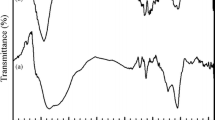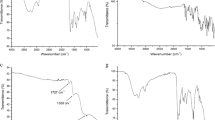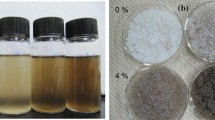Abstract
The current study sought to create graphene oxide-based superstructures for gastrointestinal drug delivery. Graphene oxide has a large surface area that can be used to load anti-cancer drugs via non-covalent methods such as surface adsorption and hydrogen bonding. To enhance the bio-applicability of graphene oxide, nano-hybrids were synthesized by encapsulating the graphene oxide into calcium alginate hydrogel beads through the dripping-extrusion technique. These newly developed bio-nanocomposite hybrid hydrogel beads were evaluated in structural analysis, swelling study, drug release parameters, haemolytic assay, and antibacterial activity. Doxorubicin served as a model drug. The drug entrapment efficiency was determined by UV-spectroscopy analysis and was found to be high at ⁓89% in graphene oxide hybrid hydrogel beads. These fabricated hydrogel beads ensure the drug release from a hybrid polymeric matrix in a more controlled and sustained pattern avoiding the problems associated with a non-hybrid polymeric system. The drug release study of 12 h shows about 83% release at pH 6.8. In vitro drug release kinetics proved that drug release was a Fickian mechanism. The cytotoxic effect of graphene oxide hybrid alginate beads was also determined by evaluating the morphology of bacterial cells and red blood cells after incubation. Additionally, it was determined that the sequential encapsulation of graphene oxide in alginate hydrogel beads hides its uneven edges and lessens the graphene oxide’s negative impacts. Also, the antibacterial study and biocompatibility of fabricated hydrogel beads made them potential candidates for gastrointestinal delivery.
Graphical Abstract












Similar content being viewed by others
Change history
19 March 2024
This article has been retracted. Please see the Retraction Notice for more detail: https://doi.org/10.1208/s12249-024-02788-9
References
Geim AK, Novoselov KS. The rise of graphene. In: Nanoscience and technology: a collection of reviews from nature journals. World Scientific; 2010; p. 11–19.
Georgakilas V. Functionalization of graphene. John Wiley & Sons. 2014.
Valentini F, Andrea C, Vincenzo R, Di Giacobbe M, Botta M, Talamo M. Graphene as nanocarrier in drug delivery. 2018.
Yang X, et al. High-efficiency loading and controlled release of doxorubicin hydrochloride on graphene oxide. J Phys Chem C. 2008;112(45):17554–8.
Smith AT, et al. Synthesis, properties, and applications of graphene oxide/reduced graphene oxide and their nanocomposites. Nano Mater Sci. 2019;1(1):31–47.
de Moraes ACM, et al. Graphene oxide-silver nanocomposite as a promising biocidal agent against methicillin-resistant Staphylococcus aureus. Int J Nanomed. 2015;10:6847.
Pourjavadi A, et al. Preparation of porous graphene oxide/hydrogel nanocomposites and their ability for efficient adsorption of methylene blue. RSC Adv. 2016;6(13):10430–7.
Wang J, et al. Self-assembled peptide nanofibers on graphene oxide as a novel nanohybrid for biomimetic mineralization of hydroxyapatite. Carbon. 2015;89:20–30.
Kundu N, et al. Graphene oxide and pluronic copolymer aggregates–possible route to modulate the adsorption of fluorophores and imaging of live cells. J Phys Chem C. 2015;119(44):25023–35.
Zhou T, Zhou X, Xing D. Controlled release of doxorubicin from graphene oxide based charge-reversal nanocarrier. Biomaterials. 2014;35(13):4185–94.
Oliveira AM, et al. Graphene oxide thin films with drug delivery function. Nanomaterials. 2022;12(7):1149.
Pandey N, Bohra BS, Tiwari H, Pal M, Negi PB, Dandpat A, Mehta S, N. G. Sahoo NG. Development of biodegradable chitosan/graphene oxide nanocomposite via spray drying method for drug loading and delivery application. J Drug Deliv Sci Technol. 2022;103555.
Rasoulzadehzali M, Namazi H. Facile preparation of antibacterial chitosan/graphene oxide-Ag bio-nanocomposite hydrogel beads for controlled release of doxorubicin. Int J Biol Macromol. 2018;116:54–63.
Dehnad D, Jafari SM, Afrasiabi M. Influence of drying on functional properties of food biopolymers: from traditional to novel dehydration techniques. Trends Food Sci Technol. 2016;57:116–31.
Rehman S, et al. Fabrication, evaluation, in vivo pharmacokinetic and toxicological analysis of pH-sensitive eudragit S-100-coated hydrogel beads: a promising strategy for colon targeting. AAPS PharmSciTech. 2021;22(6):1–17.
Li Q, et al. Recent trends in the development of hydrogel therapeutics for the treatment of central nervous system disorders. NPG Asia Mater. 2022;14(1):1–14.
Kusuma K, Nischala M, Swathi B, Ramkanth S, Kusuma S. Formulation and evaluation of Losartan hydrogel beads. Int J Pharm Drug Anal. 2014;2:788–95.
Gombotz WR, Wee SF. Protein release from alginate matrices. Adv Drug Deliv Rev. 2012;64:194–205.
Nochos A, Douroumis D, Bouropoulos N. In vitro release of bovine serum albumin from alginate/HPMC hydrogel beads. Carbohyd Polym. 2008;74(3):451–7.
Pervez S, et al. Agarose hydrogel beads: an effective approach to improve the catalytic activity, stability and reusability of fungal amyloglucosidase of GH15 family. Catal Lett. 2018;148(9):2643–53.
Jadach B, Świetlik W, Froelich A. Sodium alginate as a pharmaceutical excipient: novel applications of a well-known polymer. J Pharm Sci. 2022.
Bajpai S, Sharma S. Investigation of swelling/degradation behaviour of alginate beads crosslinked with Ca 2+ and Ba 2+ ions. React Funct Polym. 2004;59(2):129–40.
Chan E-S, et al. Prediction models for shape and size of ca-alginate macrobeads produced through extrusion–dripping method. J Colloid Interface Sci. 2009;338(1):63–72.
Buss A, Locs J. Effects of calcium and alginate concentration on the calcium-deficient hydroxyapatite hydrogel bead formation. Key Engineering Materials. Trans Tech Publ. 2017.
Cypes SH, Saltzman WM, Giannelis EP. Organosilicate-polymer drug delivery systems: controlled release and enhanced mechanical properties. J Control Release. 2003;90(2):163–9.
Justin R, Chen B. Characterisation and drug release performance of biodegradable chitosan–graphene oxide nanocomposites. Carbohyd Polym. 2014;103:70–80.
Jebel FS, Almasi H. Morphological, physical, antimicrobial and release properties of ZnO nanoparticles-loaded bacterial cellulose films. Carbohyd Polym. 2016;149:8–19.
Rasoulzadeh M, Namazi H. Carboxymethyl cellulose/graphene oxide bio-nanocomposite hydrogel beads as anticancer drug carrier agent. Carbohyd Polym. 2017;168:320–6.
Song E, et al. Hyaluronic acid-decorated graphene oxide nanohybrids as nanocarriers for targeted and pH-responsive anticancer drug delivery. ACS Appl Mater Interfaces. 2014;6(15):11882–90.
Wang H, et al. Chlorotoxin-conjugated graphene oxide for targeted delivery of an anticancer drug. Int J Nanomed. 2014;9:1433.
Barkhordari S, Yadollahi M, Namazi H. pH sensitive nanocomposite hydrogel beads based on carboxymethyl cellulose/layered double hydroxide as drug delivery systems. J Polym Res. 2014;21(6):1–9.
Kulkarni RV, et al. pH-responsive interpenetrating network hydrogel beads of poly (acrylamide)-g-carrageenan and sodium alginate for intestinal targeted drug delivery: Synthesis, in vitro and in vivo evaluation. J Colloid Interface Sci. 2012;367(1):509–17.
Aquino RP, et al. Piroxicam loaded alginate beads obtained by prilling/microwave tandem technique: morphology and drug release. Carbohyd Polym. 2012;89(3):740–8.
Zhuang Y, et al. Alginate/graphene double-network nanocomposite hydrogel beads with low-swelling, enhanced mechanical properties, and enhanced adsorption capacity. J Mater Chem A. 2016;4(28):10885–92.
Shin J, et al. Larvicidal composite alginate hydrogel combined with a Pickering emulsion of essential oil. Carbohyd Polym. 2021;254:117381.
Wang J, et al. Controlled release of anticancer drug using graphene oxide as a drug-binding effector in konjac glucomannan/sodium alginate hydrogels. Colloids Surf B. 2014;113:223–9.
Korsmeyer RW, et al. Mechanisms of solute release from porous hydrophilic polymers. Int J Pharm. 1983;15(1):25–35.
Li S, et al. A common profile for polymer-based controlled releases and its logical interpretation to general release process. J Pharm Pharm Sci. 2006;9(2):238–44.
Higuchi T. Mechanism of sustained‐action medication. Theoretical analysis of rate of release of solid drugs dispersed in solid matrices. J Pharm Sci. 1963;52(12):1145–9.
Zhang J, et al. Safe and effective removal of urea by urease-immobilized, carboxyl-functionalized PES beads with good reusability and storage stability. ACS Omega. 2019;4(2):2853–62.
Zhang B, et al. Heparin modified graphene oxide for pH-sensitive sustained release of doxorubicin hydrochloride. Mater Sci Eng C. 2017;75:198–206.
Gurunathan S, et al. Oxidative stress-mediated antibacterial activity of graphene oxide and reduced graphene oxide in Pseudomonas aeruginosa. Int J Nanomed. 2012;7:5901.
Tsao CT, et al. Antibacterial activity and biocompatibility of a chitosan–γ-poly (glutamic acid) polyelectrolyte complex hydrogel. Carbohyd Res. 2010;345(12):1774–80.
Gadkari RR, et al. Green synthesis of chitosan-cinnamaldehyde cross-linked nanoparticles: characterization and antibacterial activity. Carbohyd Polym. 2019;226:115298.
Sandle T. Antibiotics and preservatives. Pharmaceutical Microbiology: Essentials for Quality Assurance and Quality Control. 2016;171–83.
Liao K-H, et al. Cytotoxicity of graphene oxide and graphene in human erythrocytes and skin fibroblasts. ACS Appl Mater Interfaces. 2011;3(7):2607–15.
Khan SA, Akhtar MJ. Structural modification and strategies for the enhanced doxorubicin drug delivery. Bioorg Chem. 2022:105599.
Pond GR, et al. The prognostic importance of metastatic site in men with metastatic castration-resistant prostate cancer. Eur Urol. 2014;65(1):3–6.
McCarty MF, Whitaker J. Manipulating tumor acidification as a cancer treatment strategy. Altern Med Rev. 2010;15(3):264–72.
Bao C, et al. Graphene oxide beads for fast clean-up of hazardous chemicals. J Mater Chem A. 2016;4(24):9437–46.
Rehman S, et al. Enteric-coated Ca-alginate hydrogel beads: a promising tool for colon targeted drug delivery system. Polym Bull. 2021;78(9):5103–17.
Banoon SR, Ghasemian A. The characters of graphene oxide nanoparticles and doxorubicin against HCT-116 colorectal cancer cells in vitro. J Gastrointest Cancer. 2021:1–5.
Bhawal P, et al. Synthesis and characterization of graphene oxide filled ethylene methyl acrylate hybrid nanocomposites. RSC Adv. 2016;6(25):20781–90.
Shahriary L, Athawale AA. Graphene oxide synthesized by using modified hummers approach. Int J Renew Energy Environ Eng. 2014;2(01):58–63.
Deb A, Vimala R. Natural and synthetic polymer for graphene oxide mediated anticancer drug delivery—a comparative study. Int J Biol Macromol. 2018;107:2320–33.
Marcano DC, et al. Improved synthesis of graphene oxide. ACS Nano. 2010;4(8):4806–14.
Rao KM, Rao K, Sudhakar P, Rao KC, Subha M. Synthesis and characterization of biodegradable Poly (Vinyl caprolactam) grafted on to sodium alginate and its microgels for controlled release studies of an anticancer drug. 2013.
Tubón Usca G, et al. Preparation of graphene oxide as biomaterials for drug adsorption. in AIP Conference Proceedings. 2015. American Institute of Physics.
Gholamian S, Nourani M, Bakhshi N. Formation and characterization of calcium alginate hydrogel beads filled with cumin seeds essential oil. Food Chem. 2021;338:128143.
de Araújo TP, et al. Acetaminophen removal by calcium alginate/activated hydrochar composite beads: batch and fixed-bed studies. Int J Biol Macromol. 2022;203:553–62.
Sengupta I, et al. In-vitro release study through novel graphene oxide aided alginate based pH-sensitive drug carrier for gastrointestinal tract. Mater Today Commun. 2021;26:101737.
Ren L, et al. A smart pH responsive graphene/polyacrylamide complex via noncovalent interaction. Nanotechnology. 2010;21(33):335701.
He Y, et al. Alginate/graphene oxide fibers with enhanced mechanical strength prepared by wet spinning. Carbohyd Polym. 2012;88(3):1100–8.
Fan J, et al. Mechanically strong graphene oxide/sodium alginate/polyacrylamide nanocomposite hydrogel with improved dye adsorption capacity. J Mater Chem A. 2013;1(25):7433–43.
Naghshineh N, Tahvildari K, Nozari M. Preparation of chitosan, sodium alginate, gelatin and collagen biodegradable sponge composites and their application in wound healing and curcumin delivery. J Polym Environ. 2019;27(12):2819–30.
Segi N, Yotsuyanagi T, Ikeda K. Interaction of calcium-induced alginate gel beads with propranolol. Chem Pharm Bullet. 1989;37(11):3092–5.
Yotsuyanagi T, et al. Acid-induced and calcium-induced gelation of alginic acid: bead formation and pH-dependent swelling. Chem Pharm Bull. 1991;39(4):1072–4.
Yotsuyanagi T, et al. Effects of monovalent metal ions and propranolol on the calcium association in calcium-induced alginate gel beads. Chem Pharm Bullet. 1990;38(11):3124–6.
Zhang J, Wang Q, Wang A. In situ generation of sodium alginate/hydroxyapatite nanocomposite beads as drug-controlled release matrices. Acta Biomater. 2010;6(2):445–54.
Dainty A, et al. Stability of alginate-immobilized algal cells. Biotechnol Bioeng. 1986;28(2):210–6.
Elnashar MM, et al. Surprising performance of alginate beads for the release of low-molecular-weight drugs. J Appl Polym Sci. 2010;116(5):3021–6.
Sudhakar K, Moloi SJ, Rao KM. Graphene oxide/poly (N-isopropyl acrylamide)/sodium alginate-based dual responsive composite beads for controlled release characteristics of chemotherapeutic agent. Iran Polym J. 2017;26(7):521–30.
Zare-Akbari Z, et al. PH-sensitive bionanocomposite hydrogel beads based on carboxymethyl cellulose/ZnO nanoparticle as drug carrier. Int J Biol Macromol. 2016;93:1317–27.
Xie M, et al. Non-covalent modification of graphene oxide nanocomposites with chitosan/dextran and its application in drug delivery. RSC Adv. 2016;6(11):9328–37.
Hao G, Xu ZP, Li L. Manipulating extracellular tumour pH: an effective target for cancer therapy. RSC Adv. 2018;8(39):22182–92.
Henkelman S, et al. Standardization of incubation conditions for hemolysis testing of biomaterials. Mater Sci Eng C. 2009;29(5):1650–4.
Jin X, et al. High strength graphene oxide/chitosan composite screws with a steel-concrete structure. Carbohyd Polym. 2019;214:167–73.
Liu S, et al. Antibacterial activity of graphite, graphite oxide, graphene oxide, and reduced graphene oxide: membrane and oxidative stress. ACS Nano. 2011;5(9):6971–80.
Krishnamoorthy K, et al. Antibacterial activity of graphene oxide nanosheets. Sci Adv Mater. 2012;4(11):1111–7.
Majidi HJ, et al. Investigating the best strategy to diminish the toxicity and enhance the antibacterial activity of graphene oxide by chitosan addition. Carbohyd Polym. 2019;225:115220.
Author information
Authors and Affiliations
Contributions
Sadia Rehman: Ph.D scholar, develop the methodology and perform the experimentation and analysis. She is also the core writer of this manuscript. Asadullah Madni: supervisor, conceptualisation, and review. Qazi Adnan Jameel: co-supervisor, resource, and review. Faisal Usman: review. M. Rafi Raza: experimentation, analysis, and editing/review. Faiz Ahmad: co-supervisor and characterization. Hina Shoukat: analysis and review. Hamdan Aali: experimetation. Afifa Shafiq: review.
Corresponding author
Ethics declarations
Conflict of Interest
The authors declare no competing interests.
Additional information
Publisher's Note
Springer Nature remains neutral with regard to jurisdictional claims in published maps and institutional affiliations.
The authors confirmed that this research work is the original work. .
This article has been retracted. Please see the retraction notice for more detail: https://doi.org/10.1208/s12249-024-02788-9"
Rights and permissions
Springer Nature or its licensor (e.g. a society or other partner) holds exclusive rights to this article under a publishing agreement with the author(s) or other rightsholder(s); author self-archiving of the accepted manuscript version of this article is solely governed by the terms of such publishing agreement and applicable law.
About this article
Cite this article
Rehman, S., Madni, A., Jameel, Q.A. et al. RETRACTED ARTICLE: Natural Polymer-Based Graphene Oxide Bio-nanocomposite Hydrogel Beads: Superstructures with Advanced Potentials for Drug Delivery. AAPS PharmSciTech 23, 304 (2022). https://doi.org/10.1208/s12249-022-02456-w
Received:
Accepted:
Published:
DOI: https://doi.org/10.1208/s12249-022-02456-w




